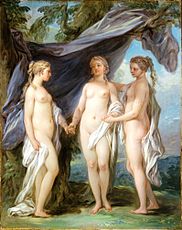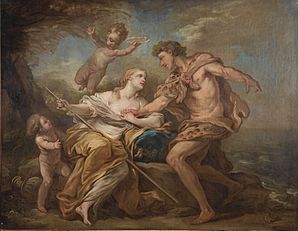Charles-André van Loo
Charles-André van Loo | |
|---|---|
 Self-portrait of Charles-André van Loo | |
| Born | 15 February 1705 Nice, Duchy of Savoy (now France) |
| Died | 15 July 1765 Paris, France |
| Education | Benedetto Luti, Rome; Académie Royale, Paris |
| Known for | Painter |
| Movement | Orientalist; Modern French school |
Carle or Charles-André van Loo (French pronunciation:
Life

He was born in Nice, then part of the Duchy of Savoy. Van Loo followed his brother Jean-Baptiste to Turin, and then to Rome in 1712, where he studied under Benedetto Luti and the sculptor Pierre Le Gros. After leaving Italy in 1723, he worked in Paris, studied at the Académie Royale, where he gained first prize for drawing in 1723, and received the first prize for historical painting in 1727[2]—as did his future rival François Boucher. In 1724 he won the Prix de Rome.
After again visiting Turin in 1727, he was employed by king
Work
By his simplicity of style and correctness of design, the result of his study of the great Italian masters, he did much to purify the modern French school; but the praise that was later lavished upon his productions now appears undue and excessive.[2] His patrons included members of the court, the Gobelins factory, private individuals, and the church. In the ensuing centuries, Van Loo's critical fortune has plummeted, although his ability remains admirable, and the quality and variety of his work command respect. His Marriage of the Virgin is preserved in the Louvre.[1][3]
Paintings
-
Painting, 1752-1753, Legion of Honor, San Francisco
-
Architecture, 1752-1753, Legion of Honor, San Francisco
-
Sculpture, 1752-1753, Legion of Honor, San Francisco
-
Music, 1752-1753, Legion of Honor, San Francisco
-
Saint Andrew
-
Portrait of Innocente Guillemette de Rosnyvinen de Pire, 1762
-
Perseus and Andromeda
-
Marie Leczinska, Queen of France (1703-1768), 1747, Versailles
-
Louis XV(1710-1774)
-
La Marquise de Pompadour, 1754-1755, Versailles, Petit Trianon
-
The Three Graces, 1763
-
Portrait of William 1st Viscount Bateman
-
Mercury and Argus
-
The Victory of Alexander over Porus
-
Theseus Taming the Bull of Marathon
-
Baccus et Ariane
-
The Adoration of the Magi
References
- ^ a b c Charles-André van Loo at the Encyclopædia Britannica
- ^ a b c d One or more of the preceding sentences incorporates text from a publication now in the public domain: Chisholm, Hugh, ed. (1911). "Vanloo, Charles Andrew". Encyclopædia Britannica. Vol. 27 (11th ed.). Cambridge University Press. p. 895.
- ^ a b "LACMA Charles-André Vanloo". collections.lacma.org. Retrieved March 7, 2015.
External links
![]() Media related to Charles André van Loo at Wikimedia Commons
Media related to Charles André van Loo at Wikimedia Commons

















